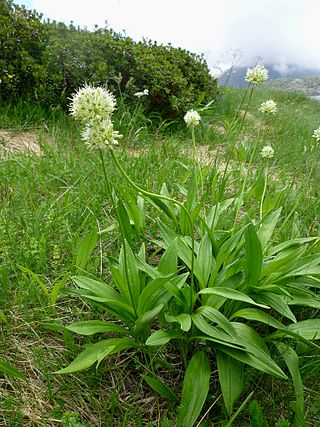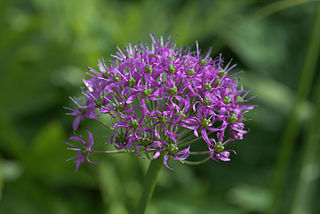
The sand leek, also known as rocambole and Korean pickled-peel garlic, is a Eurasian species of wild onion with a native range extending across much of Europe, Middle East, and Korea. The species should not be confused with rocambole garlic, which is A. sativum var. ophioscorodon.

Allium monanthum, the Korean wild chive, is a spring vegetable with minuscule bulbous roots that have a mild onion flavor and found in the woodlands of Korea, Japan, northeastern Russia (Primorye), and northeastern China.

Allium yosemitense is a California species of wild onion known by the common name Yosemite onion. Most of the known populations are situated within the boundaries of Yosemite National Park.
Allium przewalskianum is an Asian species of wild onion in the Amaryllis family.

Allium victorialis, commonly known as victory onion, Alpine leek, and Alpine broad-leaf allium is a broad-leaved Eurasian species of wild onion. It is a perennial of the Amaryllis family that occurs widely in mountainous regions of Europe and parts of Asia.
Allium atrosanguineum an Asian species of onion native to China, Siberia, Mongolia, and Central Asia. It grows high in the mountains at elevations of 2400–5400 m.

Allium hookeri is a plant species native to India, Sri Lanka, Myanmar (Burma), Bhutan, and southwestern China. Common names include Hooker chives and garlic chives.

Allium hymenorhizum is a Eurasian species of wild onion in the amaryllis family. It grows at elevations of 1100–2700 m

Allium ledebourianum is an Asian species of wild onion native to central and northeastern Asia: Kazakhstan, Mongolia, Russia, and China. It occurs at elevations up to 1800 m elevation.
Allium longistylum, also called riverside chive, is a species of wild onion native to Korea and northern China. It grows at elevations of 1500–3000 m.

Allium maximowiczii, English common name oriental chive, is an Asian plant species native to Siberia, the Russian Far East, Mongolia, Japan, Korea and northeastern China.
Allium platyspathum is an Asian species of wild onion. It has been reported from Xinjiang, Afghanistan, Kazakhstan, Kyrgyzstan, Mongolia, Altay Krai, Tajikistan, Uzbekistan, and Pakistan. It grows in damp locations at elevations of 1900–3700 m.
Allium plurifoliatum is a Chinese species of wild onion. It has been reported from Anhui, Gansu, Hubei, Shaanxi, and Sichuan at elevations of 1600–3300 m.

Allium sacculiferum, also called northern plain chive or triangular chive, is an East Asian species of wild onion native to Japan, Korea, eastern Russia, and northeastern China. It is found along the banks of lakes and rivers at elevations less than 500 m.
Allium spirale, also known as Korean aging chive, is a plant species native to Korea, Primorye, and parts of China. It is cultivated in many other regions and has for some reason obtained the common name German garlic. Other common names include spiral onion, corkscrew onion, and curly chives.

Allium thunbergii, Thunberg's chive or Thunberg garlic, is an East Asian species of wild onion native to Japan, Korea, and China. It grows at elevations up to 3000 m. The Flora of China recognizes A. tunbergii and A. stenodon as separate species, but more recent sources combine the two.
Allium tenuissimum is an Asian species of wild onion native to Mongolia, Asiatic Russia, Korea, Kazakhstan and China.

Allium wallichii is a plant species native to India, Nepal, Sikkim, Bhutan, Myanmar, and parts of China. It grows at elevations of 2300–4800 m.
Allium yongdengense is a plant species native to the Gansu and Qinghai regions in China.
Allium koreanum, the Korean rocky chive, is a species of Allium endemic to the Korean Peninsula.











